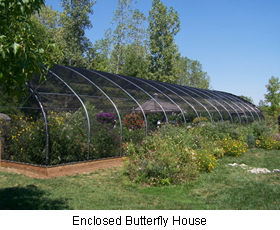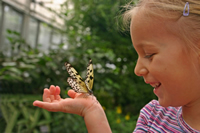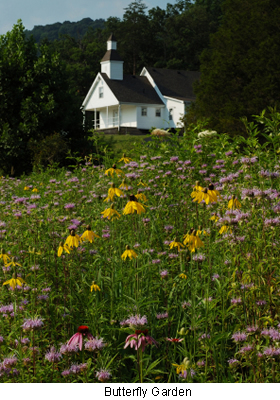Butterfly Houses and Farms

Butterfly Houses and Farms
Where can you go to learn more about butterflies? A great place to observe and study Lepidoptera is at a butterfly house, where live butterflies are in an enclosure and you can walk through their habitat. Or you can visit a public butterfly garden to see live butterflies visiting native plants. These exhibits educate and encourage people to support the creation and preservation of native butterfly habitats. The following places to visit are arranged alphabetically by state.
A butterfly house, garden or farm is an enclosed butterfly habitat where hundreds of different butterfly species live and breed in a very natural, yet controlled environment. A butterfly house is very much an observatory, where you can walk into the butterfly habitat and interact with the butterflies. And they will interact with you, too, especially if you wear bright clothing and smell good (butterflies like floral perfumes). There is little difference between a butterfly house, garden or farm, other than a farm may be more interested in breeding the butterflies than the butterfly house or garden, so the farm may have more host plants than the others.
Most butterfly farms will be open to the public with guided tours so that you and your family can walk through them and look at all of the wonderful species of butterflies of the world in one place. You can see how they eat, live, and grow, and if you are lucky, you can watch some butterflies emerge from their cocoons and take their first baby butterfly flight.
You will find two different “kinds” of plants in a butterfly house, nectar plants and host plants. Nectar plants and flowers are the kinds that produce the nectar that butterflies like to eat. There are many, many varieties of nectar plants, and you will see most of them in a large butterfly house because different species of butterflies are partial to different nectar plants. Some of the nectar plants you may see in a butterfly house are butterfly bush, rose of Sharon, hawthorn, sunflowers, marigolds, and coneflowers. Of course, these are only a few of the many, many varieties of nectar plants and flowers that butterflies love.
Host plants are the plants that caterpillars eat, and so butterflies lay their eggs on them. Caterpillars are picky eaters and if they hatch on a plant that they don’t like to eat, they won’t eat it and they won’t survive because they are unable to travel to another plant that they like better. It is important for a butterfly house to have a large variety of host plants for this reason. Some host plants include different varieties of milkweed, snapdragons, hackberry, fennel, clovers and alfalfa. There are several small and large trees that make wonderful host plants as well like willows, aspen, elm and cottonwood. You may see many of the smaller trees growing in a butterfly house.
Most butterfly houses, gardens and farms will charge a small fee or ask for a donation in order to walk through it or to take the guided tour. This fee or donation is to help the butterfly house with its butterfly conservation efforts.

Child Observes Butterfly Close-up at Butterfly House

Butterfly Houses and Farms
